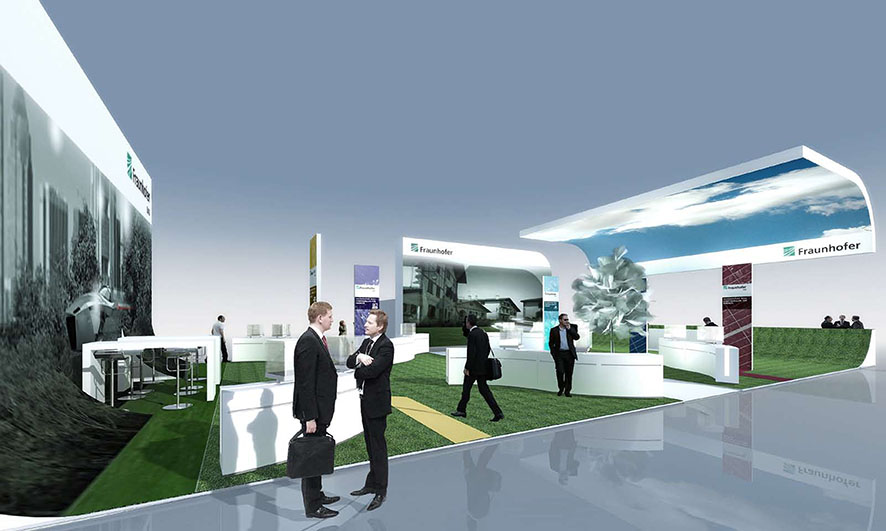Fraunhofer Building Innovation Alliance presents visions for the cities of the future at the BAU 2013 construction trade fair
To guarantee that life in the future is not just different but also better, municipalities, cities and regions must take timely measures to ensure they are properly equipped to face future global challenges that are already evident today. Increasing urbanization, growing climate variability, the transition toward a new energy economy, the ever-increasing consumption of resources, and demographic change will all play a role in defining the development of residential structures. Bringing about the future vision of “CO2-neutral, energy-efficient and climate-adapted cities” is the aim of the German government’s High-Tech Strategy 2020 action plan, recently approved by the federal cabinet. The Fraunhofer Building Innovation Alliance is already poised to present the first product and system solutions for livable, sustainable and viable cities of the future in a special show in Hall C2, Booth 131/135 at the BAU 2013 construction trade fair.
Since the consumption of energy and resources in Germany is concentrated primarily in cities, urban living environments play a major role in efforts to tackle the key challenges of the 21st century. From a technological and sociopolitical standpoint, our building and living designs are on the brink of a profound change, meaning that future urban development projects will have to be conceived and implemented differently.
Research for the future – research for the “Morgenstadt – City of the future”
The United Nations predicts that approximately 6.3 billion people will be living in cities by the year 2050 – almost twice as many as today. At the same time, a clearly foreseeable structural shift in our existing system of value creation, demographic change, and citizens’ growing urge to participate in the planning and development processes which shape their living environments also have to be taken into account. The Fraunhofer Building Innovation Alliance is among those embarking on proactive research projects to address these issues. Within the Fraunhofer-Gesellschaft research initiative “Morgenstadt – City of the Future” and as part of Germany’s High-Tech Strategy 2020, numerous member institutes are working to create innovative and sustainable solutions to help make life in future urban centers more sustainable for inhabitants and for the environment.
The vision for the cities of the future comprises seven core issues: energy, planning and construction, production and logistics, security and protection, mobility and transport, information and communications, and processes and organization. Four of these issues also provide the foundation for the Fraunhofer Building Innovation Alliance’s special show at BAU 2013, showcasing product and system solutions in the areas of planning and construction, building materials, supply technologies, and safety and security. At the construction trade fair next January, the Alliance will present its vision for future cities under the banner of “Morgenstadt – technologies for the cities of the future”. This vision makes use of immersive building and residential planning techniques aided by 3D virtual reality simulations. The new technologies it embraces for providing comfortable indoor environments and for making the operation of buildings energy-efficient and affordable include prefabricated and multifunctional window modules that offer a more convenient alternative to the usual renovation methods, renewable insulating materials made from cattail, and innovative flame retardants for timber buildings. The vision even extends to crisis-proof building supports, oxidative water-treatment methods that allow the supply of water to be decentralized, and new recycling methods and ways to facilitate the re-use of materials such as concrete or clinker that are based on molecular sorting.
How best to create buildings and residential areas in the future?
In describing the Alliance’s expertise in integrating systems into the cities of the future, Prof. Klaus Sedlbauer, Chairman of the Fraunhofer Building Innovation Alliance and director of the Fraunhofer Institute for Building Physics IBP explains: “It’s a question of how best to create buildings and residential areas that are up to the task of coping with the changes that lie ahead. When it comes to creating the city of the future, far-sighted planning is just as crucial as the use of innovative materials and processes. Many of the issues involved are so complex that an interdisciplinary approach is the only way to find solutions. This is the logic behind the Fraunhofer Building Innovation Alliance, in which 17 Fraunhofer institutes pool their considerable expertise in all matters of construction. The goal is to find ways to build, live and work, today and in the future, that are sustainable, healthy, and that conserve resources. The way to achieve this is through forward-thinking development of the products, systems and processes we use and of concepts for how we use them.”
Last modified:
 Fraunhofer Building Innovation Alliance
Fraunhofer Building Innovation Alliance